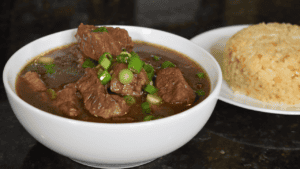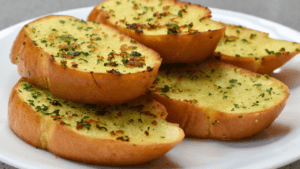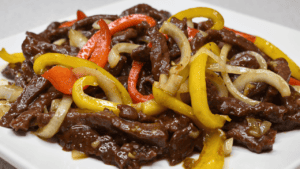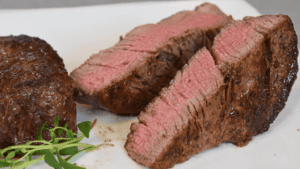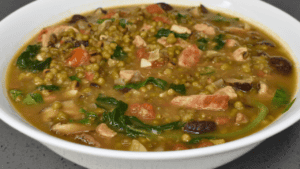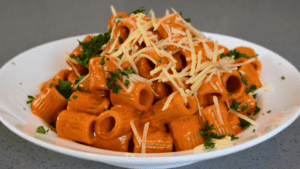Homemade Salsa
Homemade salsa is a type of spicy, flavorful sauce that originated in Mexico. This flavorful mixture of fresh ingredients, such as tomatoes, onions, peppers, and herbs, offers a unique blend of taste and texture that can elevate any dish.
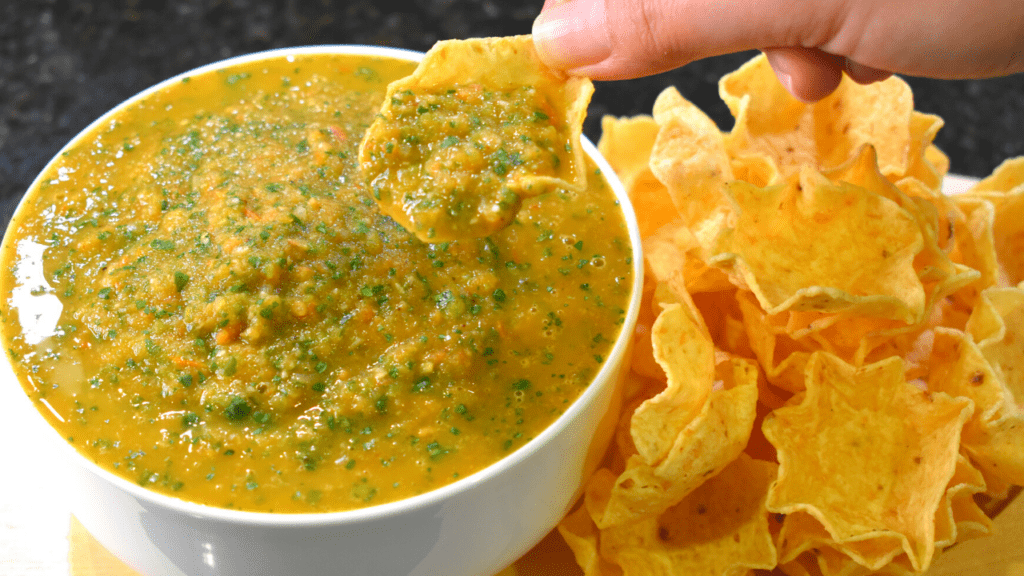
Salsa Magic in Your Kitchen: Homemade Salsa’s Secrets to Flavor and Freshness
Salsa is the heartbeat of many kitchens, adding a punch of flavor to a variety of dishes. While store-bought versions offer convenience, there’s something incredibly charming about whipping up your own batch of homemade salsa. Whether it’s serving as the perfect dip for your tortilla chips or adding a zesty kick to your tacos, homemade salsa has earned its spot as a versatile staple in cuisines around the world. For home cooks, crafting salsa not only offers a delicious outcome but also provides an opportunity to tailor the taste and texture to their personal preference. In this blog post, we’ll explore everything from the health benefits of homemade salsa to tips for customization and storage, ensuring you become a salsa connoisseur in no time.
Health Benefits of Homemade Salsa
When it comes to nutrition, homemade salsa is a powerhouse. The ingredients used in homemade salsa are rich in essential vitamins and minerals. For instance, tomatoes, a key component, are packed with vitamin C, potassium, and lycopene—an antioxidant known for its heart health benefits. Peppers add a dose of vitamin A and capsaicin, which can help boost metabolism.
Unlike store-bought versions, homemade salsa does not contain preservatives. These artificial additives, often found in packaged foods, can lead to health issues over time. By making salsa at home, you ensure that each ingredient is fresh and natural, enhancing both flavor and health benefits. Additionally, you control the sodium levels, which can be quite high in commercial salsas, making homemade options a heart-friendly choice.
Homemade salsa can support weight management goals. It’s naturally low in calories and fat, making it a guilt-free addition to any meal. Instead of heavy, calorie-laden sauces, salsa can be used to add flavor without compromising dietary goals. This makes it an excellent choice for those looking to maintain a healthy lifestyle while still enjoying their meals.
The Essential Ingredients for Homemade Salsa
The magic of a delicious salsa starts with selecting the right ingredients. Freshness is key, so head to your local farmer’s market or grocery store for the best produce. When choosing tomatoes, opt for varieties like Roma or vine-ripened tomatoes, known for their rich flavor and firm texture. They should be ripe but not overly soft to ensure a good consistency in your salsa.
Peppers provide the spice and depth of flavor. Jalapeños are a classic choice, but if you’re seeking something with a bit more heat, consider habaneros or serranos. Remember, the size and color of peppers can indicate their heat level—smaller and darker peppers tend to be spicier. For a milder option, bell peppers can add flavor without too much heat.
Don’t forget the supporting cast—onions, garlic, and cilantro. Red onions give a bit of sweetness, while white onions offer a sharper taste. Fresh garlic cloves enhance the salsa’s depth, and cilantro adds a vibrant finish. Choose cilantro that is bright green without wilting, as it indicates freshness. These ingredients come together to create a symphony of flavors that define a good salsa.
Step-by-Step Guide to Making Homemade Salsa
Creating homemade salsa is a straightforward process that allows you to enjoy fresh, flavorful results in no time. Let’s walk through it together.
Step 1: Start by broiling five large tomatoes for 30 minutes. This enhances their flavor and makes them easier to blend. While broiling, gather your other ingredients.
Step 2: Heat 1 tablespoon of olive oil in a large skillet over medium-high heat. Add six crushed garlic cloves, three chopped small onions, and one chopped green bell pepper. Sauté for about 5 minutes until the onions are translucent, then remove from heat.
Step 3: Transfer the sautéed vegetables to a blender. Pulse until roughly blended. This ensures the salsa retains some texture, which is key to a good consistency.
Step 4: Add the roasted tomatoes, 2 cups of chopped cilantro, 1 teaspoon each of salt, ground black pepper, and sugar, along with the juice of one small lemon to the blender. Blend for an additional 10 seconds, or until you reach your desired consistency.
Step 5: Serve and enjoy! Your homemade salsa is now ready to elevate any dish you pair it with.
Tips for Customizing Your Salsa
One of the joys of making salsa at home is the ability to customize it to your liking. Here are a few ideas to make your salsa stand out.
Consider adding fruits like mangoes or pineapples for a sweet twist. Their natural sugars complement the acidity of the tomatoes and add a tropical flair. When adding fruits, be sure to choose ripe ones, as they blend better and offer a sweeter taste.
For those who love spice, experiment with different types of peppers. You might try ghost peppers if you’re feeling adventurous, but remember to handle them with care. Adjusting the number of seeds left in your peppers is another way to control the heat level of your salsa.
Lastly, think about texture. If you prefer a chunkier salsa, pulse your ingredients less. For a smoother blend, process them longer. You can also add a splash of vinegar or lime juice for a tangy kick, making your salsa uniquely yours.
Storing and Serving Homemade Salsa
Proper storage is essential to maintaining the freshness and flavor of your homemade salsa. After preparing, transfer the salsa to an airtight container and store it in the refrigerator. It should last for up to a week, making it a convenient addition to your meals throughout the week.
If you have an abundance of salsa, consider freezing it. Portion the salsa into freezer-safe bags or containers, leaving some space for expansion. Homemade salsa can be frozen for up to three months. Just thaw it in the refrigerator before serving.
Serving salsa is where creativity can shine. While it’s perfect with tortilla chips, consider pairing it with grilled meats, as a topping for baked potatoes, or mixed into salads for an unexpected burst of flavor. With its versatility, salsa can enhance a wide range of dishes, making it a kitchen staple.
Conclusion
Making salsa at home not only guarantees freshness and flavor but also allows you to personalize every aspect of it. From selecting quality ingredients to experimenting with flavors and textures, the benefits of homemade salsa are numerous. It’s a healthier alternative to store-bought versions and a delightful addition to your culinary repertoire. We encourage you to try making your own salsa and share your experiences and recipes. Happy cooking!
Frequently Asked Questions
What ingredients are in salsa?
Salsa typically includes tomatoes, onions, peppers, garlic, and cilantro, but can be customized with additional ingredients like fruit or spices.
Why does Mexican restaurant salsa taste so good?
Restaurant salsa often benefits from fresh ingredients and recipes that have been perfected over time, providing a balance of flavors and textures.
Do I have to peel tomatoes for salsa?
Peeling tomatoes is optional. Some prefer the smoothness peeling provides, while others enjoy the texture of the peel.
What can I add to my salsa for more flavor?
Experiment with ingredients like lime juice, vinegar, or roasted garlic to enhance the flavor profile of your salsa.
Should you cook homemade salsa?
Cooking salsa can concentrate its flavors, but raw salsa maintains a fresh, crisp taste. Try both to see which you prefer.
Do you have to cook homemade salsa before canning?
Yes, cooking salsa ensures safe canning and proper preservation by killing bacteria before sealing.
More Delicious Recipes You’ll Love
- Chicken Quesadilla – A mouth-watering Mexican dish. It consists of a tortilla filled with cooked chicken, melted cheese, and other delicious ingredients, then folded in half and toasted on a skillet until golden brown.
- Creamy Tuscan Salmon Recipe – A mouth-watering Italian dish that combines the richness of cream sauce with the delicate flavor of salmon. The dish originated in Tuscany, a region known for its exquisite cuisine and culinary traditions.
- Walnut Shrimp – Popular Chinese-American dish that consists of large, juicy shrimp coated in a sweet and creamy sauce, topped with crunchy walnuts.
- Garlic Butter Shrimp – Delicious and flavorful seafood dish that can be made with ease at home. The recipe combines succulent shrimps, butter, garlic, and various herbs and spices to make a delightful meal.
- Baked Salmon – Delicious and healthy dish that combines the delicate flavors of fresh salmon with the rich and aromatic seasonings of various herbs and spices.
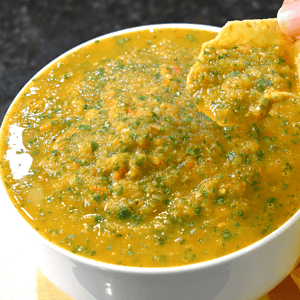
Homemade Salsa
Ingredients
- 5 large tomatoes
- 6 cloves garlic crushed
- 3 small onion chopped
- 1 medium green bell pepper chopped
- 1 tbsp olive oil
- 2 cups cilantro chopped
- 1 tsp salt
- 1 tsp ground black pepper
- 1 tsp sugar
- 1 small lemon juice
Instructions
- Broil the tomatoes for 30 minutes.
- Heat olive oil in a large skillet over medium-high heat. Add garlic, onion, and green bell pepper; sauté for 5 minutes, then remove from the heat.
- Transfer the sautéed vegetables to a blender and pulse until roughly blended. Add the roasted tomatoes, cilantro, salt, pepper, sugar, and lemon juice; blend for an additional 10 seconds.
- Serve and enjoy!
